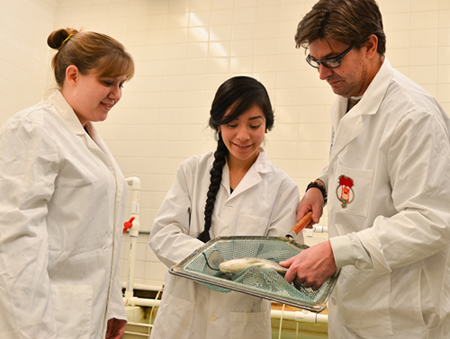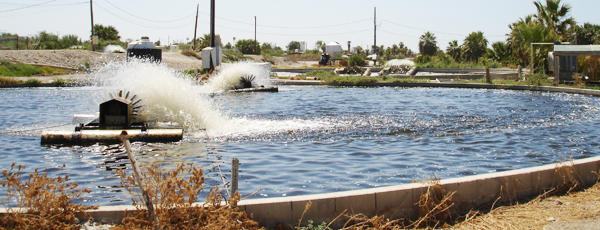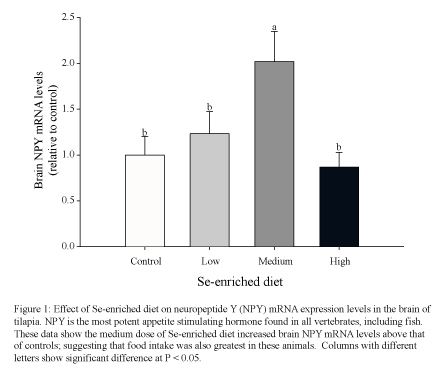California Agricultural Technology Institute
Aquaculture study could lead to new market
for selenium forage grasses
Fresno State biology professor explores selenium as nutrition supplement to tilapia feed
We’ve probably all heard the phrases “farm to market,” “farm to table,” or “farm to fridge” at one time or another. How about “farm to fish?”
This phrase could summarize the possible outcomes of a new aquaculture research study being conducted by a Fresno State biologist in collaboration with a plant and soil expert from the U.S. Department of Agriculture.
Leading the work is Dr. Larry Riley, associate professor in Fresno State’s Biology Department. Partnering with him is Dr. Gary Bañuelos, a research scientist based at the USDA’s Agricultural Research Service facility in Parlier, a few miles southeast of Fresno.
Their objective: To learn if “farmed fish” would benefit from a diet that includes selenium derived from salt- and selenium-tolerant forage grasses grown on the San Joaquin Valley’s West Side.

“With the human population nearing eight billion, the demand for safe, healthy seafood for human consumption is becoming an ever more pressing concern,” Riley said in outlining the reasoning behind the study. “Farmed fish currently accounts for 43 percent of all fish directly consumed by humans. In order to meet the growing demand on production, new biotechnologies in the aquaculture industry must emerge as has been seen in the livestock, poultry and swine industries.”
Associate Biology Professor Larry Riley examines a Tilapia specimen in Fresno State laboratory along with research assistants, post-doctoral researcher Christine Duncan (left) and undergraduate student research assistant Ivonne Lara-Umara.
New feeding technologies will not only increase yields but could preserve and improve the nutritional quality of the fish product, he added.
Since selenium (Se) is an essential trace element for nutritional health in humans and animals (including fish), Bañuelos has for years been evaluating hybridized plants for their ability to take up Se from West Side soils and be converted into a marketable product. Forage grasses such as Brassica, saltgrass and ‘Jose’ tall wheatgrass have been produced and added as an Se supplement to livestock feed with positive results.
Selenium has many potential health benefits, such as anti-carcenogenic properties beyond meeting basic nutritional requirements – so why not try an Se-enriched feed supplement, developed from a forage grass grown on the West Side, for the aquaculture industry, the researchers hypothesized.
Riley selected tilapia as the fish to use in the trials, which are already under way.
“Tilapine fish are a major protein source worldwide and have become increasingly popular in the United States – considered now the fifth most popular seafood in the country,” he said.
Key focus areas in the study are how the Se-enriched feed affects fish appetite, health, growth rates, and uptake of organic Se (e.g., selenocystiene and selenomethionine). The hypothesis is that a properly-enriched feed will enhance fish response to stress, which occurs in controlled “farm” environments.
 The first phase of the study, already completed, featured the use of four 75-gallon
fish tanks – each holding 50 fish – in Fresno State’s Biology Department laboratories.
Four feeding treatments included 1) a control featuring a conventional industry diet;
2) a low Se-enriched diet; 3) a medium Se-enriched diet; and 4) a high Se-enriched
diet.
The first phase of the study, already completed, featured the use of four 75-gallon
fish tanks – each holding 50 fish – in Fresno State’s Biology Department laboratories.
Four feeding treatments included 1) a control featuring a conventional industry diet;
2) a low Se-enriched diet; 3) a medium Se-enriched diet; and 4) a high Se-enriched
diet.
Photo shows Pacific Aquafarms in Niland, California, a partner in the research project.
Over the course of 12 weeks, sample fish were selected regularly out of each tank for evaluation of biological development -- including cortisol levels, enzyme activity, and Se concentrations in muscle.
“Based on a pilot study we previously conducted, we expect that the Se-enriched meal will increase tilapia growth above fish fed control diets,” Riley said. “This elevated growth rate is expected to be a result of a significant increase in levels of appetite stimulating hormones in the brain, as a result of the Se-enriched diet.”
Phase two of the study was conducted this past summer using only the most effective feeding treatment from the previous tests, with a similar methodology except the fish were grown under more stressful conditions. Growth traits were again analyzed during this phase.
 It is anticipated that the third phase will occur this coming summer at the site of
an industry partner, Pacific Aquaculture in Niland, California. Fish will be grown
in an actual farm setting using the four original treatments of control, along with
low-, medium- and high-Se-enriched diets. At intervals, sample fish will again be
collected and evaluated for weight gain and other characteristics.
It is anticipated that the third phase will occur this coming summer at the site of
an industry partner, Pacific Aquaculture in Niland, California. Fish will be grown
in an actual farm setting using the four original treatments of control, along with
low-, medium- and high-Se-enriched diets. At intervals, sample fish will again be
collected and evaluated for weight gain and other characteristics.
“We expect that fish fed the Se-enriched fish meal will be able to tolerate the negative effects of stress and high-density rearing – exhibiting positive growth – better than fish fed the control diet,” he said.
Much research and development already has been done on feed and supplements for the aquaculture industry, the biologist noted.
“The key to this work is coupling the process of phytomanagement of naturally occurring Se on the West Side San Joaquin Valley with the production of a safe, nutritionally-fortified Se-enriched fish feed for use in the aquaculture industry—a form of Se-biofortified fish,” he said
Following completion of the experiments and analysis of the results later this year, Riley and Banuelos plan to release results to the aquaculture and agriculture industries through various means.
This project was supported by Agriculture and Food Research Initiative Competitive Grant No. 2010-65206-20615 from the USDA National Institute of Food and Agriculture. Additional financial support was provided by the California State University Agricultural Research Institute (12-2-013-23). For more information, contact Riley at lriley@csufresno.edu or Bañuelos at gary.banuelos@ars.usda.gov.